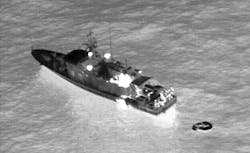FLIR Systems to provide electro-optical visible-light and infrared cameras for surface warships
CRANE, Ind., 21 Sept. 2015. U.S. Navy maritime surveillance experts needed upgraded long-range electro-optical forward-looking infrared sensors for surface warships operating in coastal waters and harbors. They found their solution from FLIR Systems Inc. in Billerica, Mass.
Officials of the Naval Surface Warfare Center in Crane, Ind., announced a $49.9 million contract to FLIR Systems on Friday to provide Combatant Craft Forward Looking Infrared variant 2 (CCFLIR2) infrared and visible-light cameras.
The CCFLIR2 is a day-and-nighttime visible-light camera combined with infrared imaging system that enables operators to detect surface targets at tactically significant ranges in all operational environments, Navy officials say.
The sensor system, packaged in a stabilized gimbal assembly, provides increased detection, recognition and identification ranges in all conditions over what is available today, as well as constant interrogation of targets across the spectrum of naval operations.
Related: FLIR Systems to provide Navy with multi-sensor electro-optical imaging system
The CCFLIR2 provides enhanced situational awareness with high-definition imaging and zoom capability, and includes improved optics and image processing that enable the user to see the same target in several different wavelengths to highlight target features and discriminators.
CCFLIR2 integrates with embedded navigational systems and other shipboard systems to provide target and way-point geolocation and tracking functionality, and is part of a collection of intelligence, surveillance, and reconnaissance systems available for use on special operations force maritime vessels.
The CCFLIR2 will be a significant upgrade to the fielded legacy CCFLIR surface ship sensor system, and will enhance and expand shipboard day, night, and infrared imaging capabilities. Navy experts will install the CCFLIR2 system aboard naval maritime vessels of various types that operate in littoral waters.
FLIR systems will provide a CCFLIR2 system with stabilized gimbal assembly; hand control unit; display bracket assembly; installation kit; interface cable kit; and reusable shipping container.
The stabilized gimbal assembly will have high-definition medium-wave infrared imager, high-definition color imager, near-infrared imager, laser range finger, laser pointer, optics and zoom lenses, and combination anti-spoofing GPS receiver and inertial measurement unit.
The stabilized gimbal also will have 360-degree panoramic view capability for all its sensors, and dual- band high-definition 3-5-micron medium-wave infrared sensor and 8-to-12-micron long-wave infrared imaging sensor.
On this contract FLIR Systems will do the work in Billerica, Mass., and should be finished by September 2025. For more information contact FLIR Systems online at www.flir.com, or the Naval Surface Warfare Center-Crane at www.navsea.navy.mil/Home/WarfareCenters/NSWCCrane.


